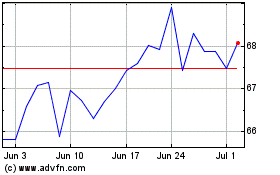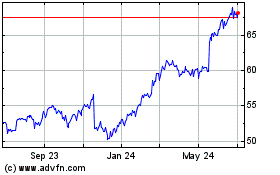Inventory Pullback a Drag on Logistics Spending
June 21 2016 - 9:29AM
Dow Jones News
By Paul Page
A year-long pullback in U.S. business inventories will likely
continue through the rest of 2016 as retailers and manufacturers
remain cautious amid uncertain demand and the prospects for higher
interest rates, according to a report on U.S. logistics.
The tight lid on inventories, a drag on U.S. economic growth in
the first quarter, comes as companies are paring back after
overstocking in recent years while they tried to adjust to changes
in consumer buying patterns, said the authors of the annual State
of Logistics report released Tuesday. The report was produced by
A.T. Kearney for the Council of Supply Chain Management
Professionals.
Inventories in previous years grew faster than the economy as a
whole, a trend that halted in 2015 as growth slowed and big
retailers like Wal-Mart Stores Inc. and Target Corp. scaled back,
said Sean Monahan, a partner at A.T. Kearney and the main author of
the report.
"We would expect to see inventories through the rest of the year
increase in line with GDP growth," Mr. Monahan said. "We won't see
a return to a 5% growth rate [for inventories] that we had been
seeing."
The inventory pullback has roiled the logistics sector.
It has hit transportation companies hard since they are holding
expensive assets that they added between 2011 and 2014. Lighter
volumes have led ship operators and trucking companies to slash
their prices, eating into profit margins. The trucking industry has
75,000 to 80,000 more trucks than companies need to move goods,
said Marc Althen, president of Penske Logistics, a sponsor of the
CSCMP report.
"As a carrier, you're either parking it or lowering your rate to
keep the trucks spinning," said Mr. Althen.
Logistics services companies -- which do not own transportation
equipment -- have fared better, and taken advantage of the lower
rates. And the move to get goods closer to cities and consumers in
response to the growth of online sales has fueled stronger earnings
at industrial real estate companies that manage warehouses.
Retailers began slowing down their inventory replenishment
around the middle of 2015 as consumer sales faltered. A rush of
goods following the resolution of labor strife at West Coast ports,
where enormous stacks of imports had piled up early in 2015, added
to a big mismatch between supply and demand.
A big correction last fall meant businesses ended up adding
barely more inventory overall last year than they had in 2014. The
CSCMP report showed total business inventories expanded by $60
billion, or just 0.2%, to $2.515 trillion in 2015 while nominal
gross domestic product grew by nearly $600 billion from the year
before.
Total business inventory as a percentage of GDP fell to 14% from
14.5% in each of the previous three years, and the lowest share of
GDP since 2010.
"When things slow down it takes time to adjust, and at the same
time when the economy picks up companies still try to be efficient
and burn off inventories," said Rick Camacho, vice president of
global supply chain operations at Hershey Co. "The supply chain is
a big ship and it takes a long time to slow it down and a long time
to get it moving again."
Mr. Monahan said a rising cost of capital has dampened
investment, with the inventory-carrying rate -- or the cost of
holding goods -- rising 5.1% last year.
One cloud on the horizon is a potential a Federal Reserve
interest rate increase later this year, which Mr. Monahan said
would further temper business investment.
Write to Paul Page at paul.page@wsj.com
(END) Dow Jones Newswires
June 21, 2016 09:14 ET (13:14 GMT)
Copyright (c) 2016 Dow Jones & Company, Inc.
Walmart (NYSE:WMT)
Historical Stock Chart
From Mar 2024 to Apr 2024

Walmart (NYSE:WMT)
Historical Stock Chart
From Apr 2023 to Apr 2024
